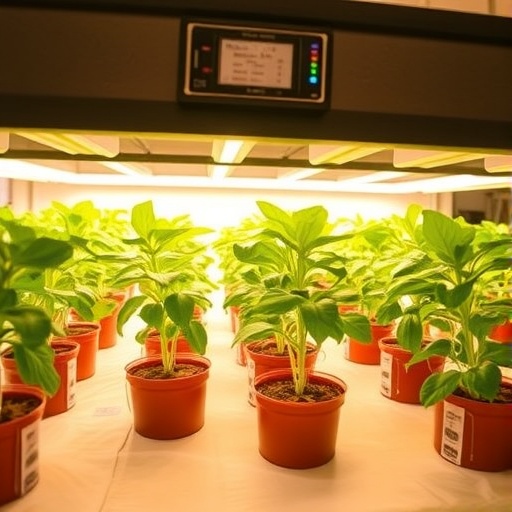Research in sustainable agriculture has taken considerable strides in recent years, emphasizing the critical role of lighting in enhancing crop growth. A pivotal study by Khan, Alam, and Gul unveils the immense potential of phosphor converted LED (pc-LED) technologies in indoor farming. This innovation stands at the intersection of agriculture and energy efficiency, heralding a new era where indoor crops may not only flourish but do so with minimized energy consumption. The researchers assert that the adoption of pc-LEDs can redefine agricultural productivity while contributing positively to environmental sustainability.
Indoor farming systems have gained prominence due to their ability to produce food year-round, irrespective of external climate conditions. However, one of the primary challenges in these systems has been achieving optimal growth conditions for plants. Photoperiod, light intensity, and spectrum play an essential role in determining plant health and productivity. As traditional lighting solutions falter under these demanding requirements, researchers have sought alternatives that provide not only efficiency but also adaptability to various crops’ needs.
Phosphor converted LED technology represents a significant leap forward in this regard. By incorporating phosphors into LED designs, researchers can create light spectra that cater specifically to the photosynthetic requirements of different plant species. This customization is crucial as distinct crops exhibit varying needs for light intensity and spectral composition during their growth stages. The adaptability of pc-LEDs allows for precise modulation of lighting conditions, promoting optimal growth environments and maximizing yield.
Moreover, the environmental implications of switching to pc-LEDs are profound. Traditional lighting systems, especially high-intensity discharge lamps, are notorious for their energy inefficiency and high heat output. This results in increased operational costs due to elevated cooling demands in indoor facilities. In contrast, pc-LEDs consume significantly less power and dissipate minimal heat, facilitating energy savings that can be reinvested into other operational aspects of farming. Given the global push towards reducing carbon footprints and energy consumption, the scalability of pc-LED technology is an exciting prospect for eco-conscious cultivators.
In addition to energy savings, the longevity of pc-LEDS adds an economic advantage. Traditional grow lights often need replacement every few years due to degradation in light output. However, pc-LED units boast lifetimes of up to 50,000 hours or more, rendering them a wise investment for long-term agricultural ventures. The diminished need for frequent replacements also translates into lower maintenance costs and reduced waste, marking a step toward greener agricultural practices.
But the strengths of pc-LEDs extend beyond mere economic and environmental benefits. The tailored light spectra they provide can lead to substantial improvements in crop quality. Studies have shown that specific wavelengths, such as blue and red light, can enhance various physiological processes in plants, such as flowering and fruiting. By utilizing pc-LEDs, farmers can manipulate these processes to produce more robust seedlings, higher fruit yields, and even enhanced nutritional profiles, thus meeting consumer demands for healthier produce.
The implementation of pc-LEDs in indoor agriculture also weaves into the broader narrative of food security. As the global population continues to expand, ensuring an adequate food supply becomes an urgent challenge. Urban areas are increasingly becoming hotspots for innovative agricultural practices, with indoor farming proposals being a prominent solution. In densely populated cities, where arable land is limited, utilizing phosphor converted LED technology in controlled environments could play a crucial role in bridging the gap between food demand and supply.
Additionally, the potential for research and development in this arena is vast. The findings presented by Khan et al. spur inquiry into various crops and growth methods, paving the way for tailored lighting strategies that maximize the potential of diverse agricultural practices. Collaborations between researchers, technologists, and agricultural practitioners could lead to groundbreaking findings that further enhance crop growth and productivity, making pc-LEDs a pivotal hardwood in future farming paradigms.
Moreover, indoor farming systems, powered by energy-efficient pc-LEDs, could contribute significantly to reducing the carbon footprint associated with food transportation and storage. By cultivating crops closer to urban areas, the reliance on long-haul transport diminishes, resulting in less fuel consumption and spoilage. This holistic approach to sustainability reaffirms the critical connection between energy-efficient technologies and the future of global food systems.
As these insights gain traction, the agricultural community must engage in discussions surrounding the infrastructural shifts needed to embrace this technology fully. Besides the initial capital investment in transitioning to pc-LED systems, there lies the necessity for training and education so that farmers can optimize the benefits of controlled-environment agriculture. This education would ensure that both established and aspiring growers understand how to harness the full potential of this remarkable lighting technology.
In conclusion, phosphor converted LED technologies present a promising pathway for enhancing indoor crop growth and agricultural productivity. The intersections of energy efficiency, environmental sustainability, and enhanced agricultural outcomes underscore the significance of this innovation. Khan, Alam, and Gul’s research not only underscores the technological advancements within indoor agriculture but also highlights the vital steps toward addressing global food challenges. As the world looks toward sustainable solutions, the integration of PC-LED technology stands poised at the forefront of agricultural evolution, offering a beacon of hope in the quest for a sustainable and productive future.
Subject of Research: Phosphor converted LED technologies in indoor agriculture.
Article Title: Phosphor converted LED technologies as a sustainable lighting strategy to enhance indoor crop growth and agricultural productivity.
Article References:
Khan, S.U., Alam, O., Gul, S. et al. Phosphor converted LED technologies as a sustainable lighting strategy to enhance indoor crop growth and agricultural productivity.
Discov Sustain 6, 1284 (2025). https://doi.org/10.1007/s43621-025-02043-6
Image Credits: AI Generated
DOI: https://doi.org/10.1007/s43621-025-02043-6
Keywords: phosphor converted LED, indoor farming, sustainable agriculture, energy efficiency, crop productivity, ecological impact, food security, urban agriculture.




